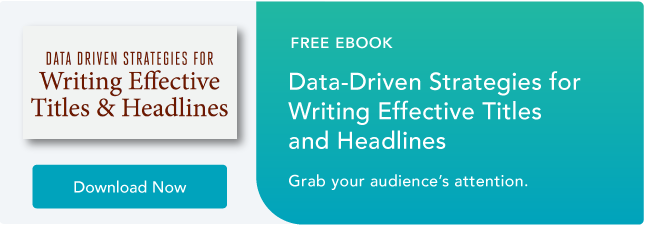 Writing exceptional blog titles is something of an art form. In fact, a great title is often the difference between a business blogging article that generates a few views and an article that generates tons of views.
Writing exceptional blog titles is something of an art form. In fact, a great title is often the difference between a business blogging article that generates a few views and an article that generates tons of views.

While the title isn't the only important element of a blog post, it is usually a potential reader's first impression of your content. Think about it: a link to a blog post shared in social media is usually only accompanied by a title, so you better make sure that title is darn good if you want people to click on it.
Luckily, you too can learn the art of writing exceptional blog titles. All you need is to understand and emulate the following 6 characteristics ... and a little practice.
6 Characteristics of Exceptional Blog Titles
1. Actionable: A great blog title is actionable, not passive. Most likely, your readers want to learn something from reading your post. Use your blog title to demonstrate that your article will give them action-oriented takeaways by incorporating verbs and other action words from the get-go. An actionable title will also give readers the impression that your blog article is a must-read. Notice how actionable the following title example is, indicating that the reader will learn how to create a Google+ Page.
Example: "How to Create a Google+ Business Page in 5 Simple Steps"
2. Brief: Be concise and to-the-point in your blog title. Punchy blog titles are much more sharable and effective than long, drawn-out titles, which can sound complicated and lose a potential reader's interest quickly. A good rule of thumb is to keep your title around 8 words or fewer, as demonstrated by the following example.
Example: "101 Signs You're an Inbound Marketer"
3. Keyword-Conscious: With many blogging platforms, your blog article's title also doubles as the page title for that web page. And anyone with a basic understanding of search engine optimization understands the importance of the page title. Incorporating appropriate keywords your business is targeting in your blog title is a great way to get more SEO bang for your buck. HubSpot, for example, is running a campaign this month about marketing automation, and the following blog article appropriately targets that specific keyword.
Example: "10 Things We Hate About Marketing Automation"
4. Clear: One of the goals you should have when creating your blog title is to clearly communicate what the article is about. Avoid language that is vague. Ask yourself, "If I read this title, would I have a clear indication of what the content I'm about to read will tell me?" If you can't easily answer that question, you probably need to re-work your title. In the below example, the title makes it obvious that the reader is going to learn various ways to make his/her content more visual -- 6 ways, to be exact.
Example: "6 Creative Ways to Make Content More Visual"
5. Definitive: Show potential readers you are an authority on the topic you're writing about. Use words that are strong and definitive. Leave wishy-washy language out, and avoid questions. Be confident in your writing. After all, if you're not confident that what you write is awesome, why should others be? The following title, for example, couldn't be any more confident.
Example: "The 15 Best Facebook Pages You've Ever Seen"
6. Intriguing: Potential readers should take one look at your title and think to themselves, "Ooo... that sounds interesting." A lot of times, this will depend on the blog's topic itself. Are you writing about something that would actually be interesting to your target audience? If so, it shouldn't be difficult to come up with an intriguing title. If so, you might want to reconsider your blog topic in general. Consider adding a little mystery into your title. While you might think this advice is a bit counterintuitive to our point about being clear, there's a right way to do this. They key is to indicate what the reader will learn from reading the blog post without actually telling them exactly what it is. Consider the following example. The reader knows he/she will be reading about a content marketer's confessions, but the reader has no idea what those confessions are. Even just the word 'confessions' alone implies intrigue.
Example: "Confessions of a Content Marketer"
Create a blog title that incorporates these 6 characteristics, and we can bet you'll be well on your way to mastering the art of exceptional blog titles that generate more views and ultimately, more leads!
Image Credit: Ruth Boraggina


![13 Types of Blog Headlines That'll Get You More Traffic [+ Examples]](https://53.fs1.hubspotusercontent-na1.net/hubfs/53/Headline-Examples.jpg)


![How to Write Better Headlines [Infographic]](http://53.fs1.hubspotusercontent-na1.net/hubfs/53/write-catchy-headlines.jpeg)
![A Data-Backed Approach to Writing Great Headlines [Infographic]](http://53.fs1.hubspotusercontent-na1.net/hubfs/53/write-effective-headlines.jpeg)
